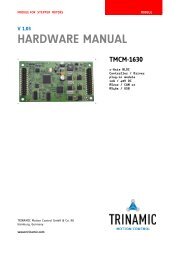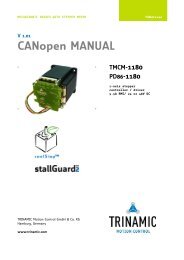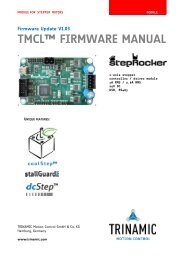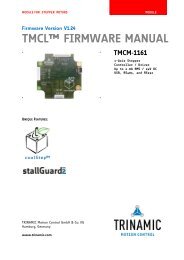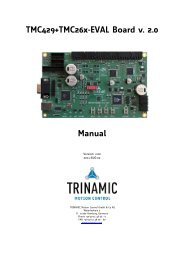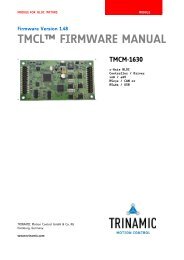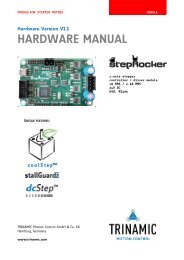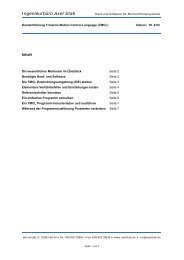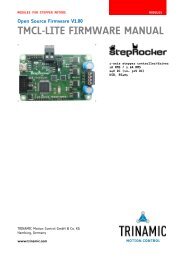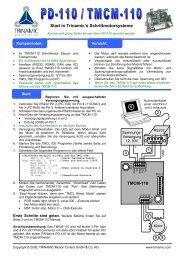TMC428 – Application Note - Trinamic
TMC428 – Application Note - Trinamic
TMC428 – Application Note - Trinamic
Create successful ePaper yourself
Turn your PDF publications into a flip-book with our unique Google optimized e-Paper software.
<strong>TMC428</strong> <strong>–</strong> <strong>Application</strong> <strong>Note</strong> <strong>–</strong> <strong>TMC428</strong> Getting Started <strong>–</strong> Including StallGuard TM 12<br />
(v. 2.00 / April 14, 2008)<br />
3.2 How to Get the Status Bits of TMC246 / TMC249 <strong>–</strong> Code Example<br />
The following C code example (part of tmc428demo.zip) outlines how to get the raw status bits of each<br />
TMC246 or TMC249 driver. This is just a little data shifting.<br />
void tmc428_get_tmc24x_status_bits( int *sm0_status, int *sm1_status, int *sm2_status )<br />
{<br />
long int datagram_low_word, datagram_high_word;<br />
int lsmd;<br />
}<br />
// this routine assumes a chain of up to three TMC246 / TMC249 drivers<br />
// pls. refer <strong>TMC428</strong> datasheet v. 2.02 / April 26, 2007 or newer<br />
tmc428_get_datagram_words( &datagram_low_word, &datagram_high_word );<br />
// 1st, determine the number of TMC246 resp. TMC249 stepper motor drivers<br />
tmc428_get_lsmd( &lsmd );<br />
switch (((char)lsmd))<br />
{<br />
case 3 : ; // <strong>TMC428</strong> interprets LSMD=3 as LSMD = 2 // NO "break;"<br />
case 2 : *sm0_status = 0x0fff & ( datagram_high_word >> 0 ); // motor #1<br />
*sm1_status = 0x0fff & ( datagram_low_word >> 12 ); // motor #2<br />
*sm2_status = 0x0fff & ( datagram_low_word >> 0 ); // motor #3<br />
break;<br />
}<br />
case 1 : *sm0_status = 0x0fff & ( datagram_low_word >> 12 ); // motor #1<br />
*sm1_status = 0x0fff & ( datagram_low_word >> 0 ); // motor #2<br />
*sm2_status = 0x0000; // motor #3<br />
break;<br />
case 0 : *sm0_status = 0x0fff & ( datagram_low_word >> 0 ); // motor #1<br />
*sm1_status = 0x0000; // motor #2<br />
*sm2_status = 0x0000; // motor #3<br />
break;<br />
3.3 How to Get the StallGuard Load Indicator (LD) Bits of TMC246 / TMC249<br />
The following C code example (part of tmc428demo.zip) outlines how to get the load indicator bits of<br />
each TMC246 or TMC249 driver to be used for StallGuard.<br />
void tmc428_get_tmc24x_stallguard_bits( int sm, int *ld )<br />
{<br />
int sm0_status, sm1_status, sm2_status;<br />
}<br />
tmc428_get_tmc24x_status_bits( &sm0_status, &sm1_status, &sm2_status );<br />
switch (((char)sm))<br />
{<br />
case 0 : *ld = 0x7 & ( sm0_status >> 9 ); break;<br />
case 1 : *ld = 0x7 & ( sm1_status >> 9 ); break;<br />
case 2 : *ld = 0x7 & ( sm2_status >> 9 ); break;<br />
}<br />
At a given speed, a stall of the motor is detected by comparing load indicator bits (LD2, LD1, LD0)<br />
forming a three bit vector LD with a threshold. The threshold has to be determined for a given stepper<br />
motor within its application. The StallGuard signal (load indicator bits) depends on the speed of the<br />
motors.<br />
Copyright © 2005-2008 TRINAMIC Motion Control GmbH & Co. KG



